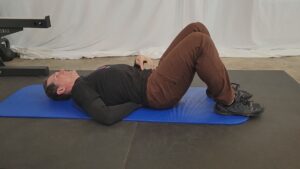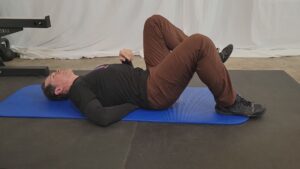Having tight hamstrings will increase your risk of injury even when performing minor daily work or recreational activities. However, I’m covering why stretching your tight hamstrings will actually cause an increase in future back pain issues.
The most common reasons why you have tight hamstrings and low back pain. Plus, how this affects your chances of low back pain and injury in the future.
Many people sit for long periods of time. Whether it’s at a desk working, while driving, or even at home relaxing in front of the TV at night recovering from a hard day’s work. Over time, this position causes a shift in your normal posture.
 The extended time in this position causes your quads and your hip flexors to become shortened which pulls your pelvis forward. These muscles are in the front of your legs and up into your pelvis. When this happens, your hamstrings tend to become weakened and the hamstrings are pulled tight. In this case your hamstrings are tight, but they’re actually elongated and weak. And you will notice these tight hamstrings much more than the short tight quads and the hip flexors.
The extended time in this position causes your quads and your hip flexors to become shortened which pulls your pelvis forward. These muscles are in the front of your legs and up into your pelvis. When this happens, your hamstrings tend to become weakened and the hamstrings are pulled tight. In this case your hamstrings are tight, but they’re actually elongated and weak. And you will notice these tight hamstrings much more than the short tight quads and the hip flexors.
The other aspect that can cause your hamstrings to become tight is if you have weak core muscles.
This increases the pressure in your low back from the forces your lumbar spine encounters. Your hamstrings are one of the first muscles that will tighten in an attempt to stabilize your lumbar spine. Weak core muscles also cause your lumbar spine to straighten out which reduces the mobility of your low back. This is how your body attempts to protect your low back from potential injury.
Stretching these hamstrings leads to an increase of chance of future low back pain and even injury.
In both cases I presented above, stretching your hamstrings will lead to future pain and increased risk of injury.

When you have tight quads and tight hip flexors, stretching your hamstrings will allow both your quads and hip flexors to shorten even more while your hamstrings continue to elongate. This allows your pelvis to tilt further forward which increases pressure on your lumbar spine. The most common area in your low back to become exposed to this pressure is the L5/S1 disc.
If your core muscles are weakened, stretching your hamstrings will decrease your spinal stability and allow the low back to become more exposed to forces your body experiences which increases your risk of injury. This allows the normal level of forces your lumbar spine takes on to put an increased level of pressure through your lumbar vertebras.
How to address your tight hamstrings that will alleviate your low back pain.
There are two different fixes, one for each issue. I would perform both of these fixes regardless of which issues is causing your tight hamstrings. Start with stretching your quads and your hip flexors.

To stretch your quads, you want to lay face down with both legs straight. Now bend one leg and grab that leg around your ankle. Pull this into the stretch and hold for 20 to 30 seconds or more if needed. Stretch both sides at least twice. Note: If you have an issue reaching the leg because it’s too tight, use a strap or towel and wrap that around your ankle so that this can assist you in stretching your quad.
To stretch your hip flexors, kneel on one knee and place the opposite foot out in front of you so that you’re in a lunge position. Make sure you place a thick mat, towel, or something else that’s soft under your knee that’s in contact with the ground. This is to protect your knee and to make this stretch as comfortable as possible. Next reach up with the arm on the same side as the knee that’s on the ground. Grab that wrist with your other hand. Now what you’re going to do is lean your body backwards while pressing your hips forward. From this position lean your body away from the side where the knee is on the ground. Pull this into the stretch and hold for 20 to 30 seconds or more if needed. Stretch both sides at least twice. 
The other area to address is your abdominals and specifically your lower abdominals which are the most common core muscle that’s weak.

Lay face up with your knees bent and place your hand underneath your low back roughly at the same position as your belly button. Put slight but steady pressure on your hand with your low back and pull your belly button in towards your spine. Raise one leg up and lower it back down for 8 to 12 reps or until you cannot keep pressure on your hand, whichever comes sooner. Repeat this on the other side.
You should be able to perform at least 10 reps for three sets on each side while keeping constant pressure on your hand with your low back before advancing this exercise to a more difficult level.
 To advance this exercise straighten your leg out a little but keep your knee flexed in this position and repeat the same process.
To advance this exercise straighten your leg out a little but keep your knee flexed in this position and repeat the same process.
When you’re able to perform this exercise with a fairly straight legs bend your knees back to the original starting position and perform this exercise with both legs at the same time.
 Keep in mind this can be a big jump with doing both legs from the single leg so proceed with care.
Keep in mind this can be a big jump with doing both legs from the single leg so proceed with care.
Comments are closed